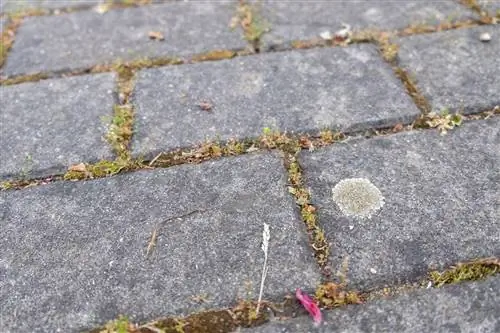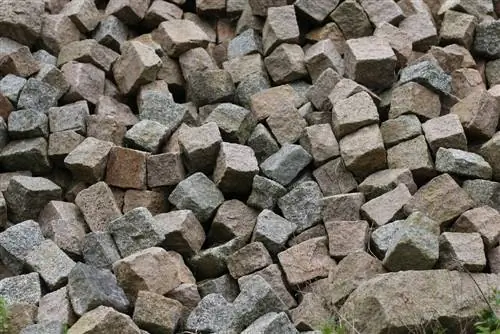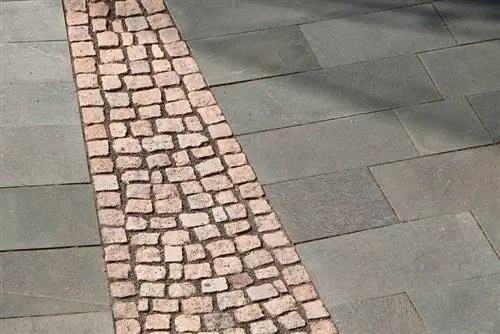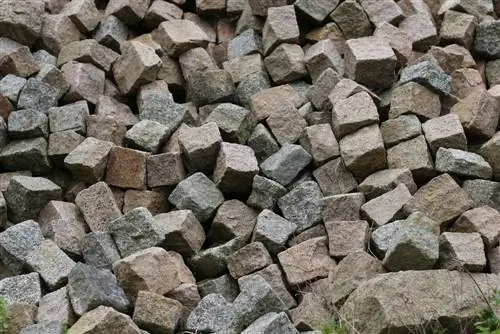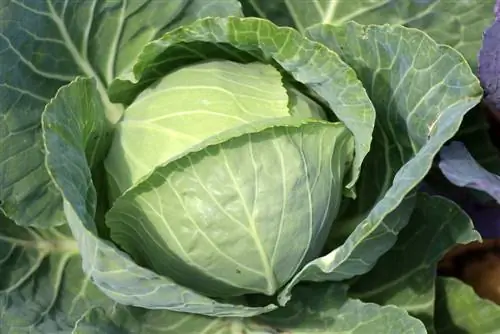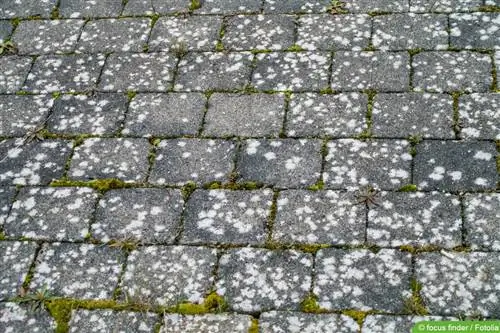- Author admin [email protected].
- Public 2023-12-17 03:39.
- Last modified 2025-01-24 12:45.
These mushrooms are lichens that are classified as fungi. They form living communities with each other or with other partners, e.g. B. Algae. Removing white fungus from paving stones is difficult.
Causes of Lichen
Lichens generally grow on all solid outdoor surfaces, although some species have adapted particularly well to different lighting conditions and humidity. They are very frugal and extremely resilient. White lichen often appears as white spots of different sizes and can actually look like mold from a distance. They can appear as a simple crust or as a branched structure in the shape of a coral. Unfortunately, these deposits are very stubborn and removing them is extremely strenuous and time-consuming.

Note:
Lichen is actually an indication of good air, because the less pollutant it is, the easier it is for lichen to form on paving stones. And as the environmental conditions have continued to improve in recent years, lichens and algae are settling even more quickly.
When should you remove it?
These white fungi are often only removed superficially or only the visible part. However, the fungus is still present and can form new fruiting bodies again. Even the wind can cause other types of lichen to settle on the paving stones. This makes it all the more important to remove them thoroughly, but still in a way that is gentle on the stone and the environment. But when should you definitely remove them?
- when coating begins to spread
- Danger of colonization of further lichen species
- Lichens secrete organic acids
- Acids attack paving stones, causing them to weather
- Lichen slippery when wet, risk of accident
- remove as early as possible
- if necessary several times a year
- depending on environmental conditions
Elimination measures
White fungi on paving stones can only be removed with a lot of effort. But the longer you wait, the harder it becomes. There are different, more or less effective methods available for this purpose. They can be removed manually with a broom or high-pressure cleaner or with household remedies such as baking soda or vinegar.

With broom or brush
Depending on the size of the area to be worked on and the type of rock, wire brooms or brushes can be used to remove stubborn lichen, as the wrong method can cause great damage to sensitive rock. As an alternative to wire brushes, other brushes with hard bristles can also be used. They are available in different strengths.
- for rough surfaces wire brooms and brushes
- but can also roughen the surface
- Removing lichen will be even more difficult in the future
- for sensitive surfaces, brushes with softer bristles
- Advantage, no scratching of the surface
- Wetting and roughing lichens
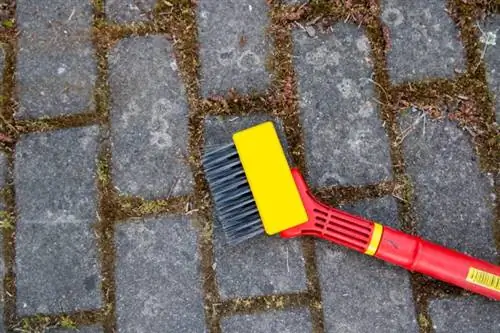
Tip:
Brushes with a telescopic handle can make work much easier because you don't have to bend down.
High-pressure cleaner
Using a high-pressure cleaner is particularly useful on larger areas with insensitive pavement. For softer rocks such as limestone or sandstone, you should avoid using a high-pressure cleaner if possible. Here it could cause invisible cracks and other surface damage that would encourage re-establishment of lichens. It is best to use a high-pressure cleaner where the pressure can be individually adjusted. Then we can get started.
- don't get too close to the stones
- preferably clean with hot water
- set low pressure first
- if this is not enough, increase it a little
- Spray lichens from different directions
- only use light pressure in joints
- After cleaning, spray the surface with water
- Re-apply joints if necessary

Note:
If you have a high-pressure cleaner where the pressure cannot be regulated, you should spray from a distance and then work your way up slowly to avoid damaging the stone.
With home remedies
It has been known for a long time that home remedies can also be used as a cost-effective alternative against many stains and other problems.
Vinegar cleaner or vinegar essence
Vinegar is only partially suitable for removing lichens from paving stones. In addition, if it gets into the surrounding soil, it can change the pH value of the soil, seep into groundwater and kill plants and microorganisms. It's not for nothing that vinegar is banned as a weed killer. So if you want to try it, you should proceed carefully.
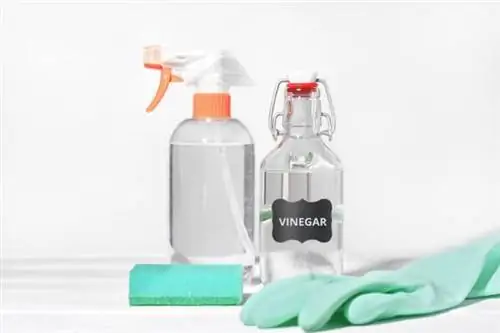
- Make a mixture of one part vinegar and 10 parts water
- fill into watering can or sprayer
- Spray lichens with it
- let it take effect briefly
- scrubbing with a hard brush and lots of water
- finally rinse with plenty of water
Note:
Vinegar is completely unsuitable for paving made of natural stone or concrete, because it would dissolve the lime from these stones, and white lime edges would be just one result. If used long-term, the acid would erode the stone and make it porous.
Baking soda and water
Baking soda in the form of powder can be found in almost every household because it can be used in a variety of ways. But it is also suitable for outdoor use, for example for removing white fungi or lichen from paving stones. You need at least ten liters of water and 20-30 g of baking soda, depending on the size of the area to be treated. Then proceed as follows:
- Removing coarse dirt from paving stones with a broom
- Bring water to a boil
- fill into large bucket
- then add baking soda, mix the whole thing thoroughly
- Solution should be free of lumps
- Spread the finished solution onto affected paving stones
- leave on for at least 24 hours
- brush the area thoroughly the next day
- Finally, rinse the plaster with plenty of water
Tip:
It shouldn't rain during the entire cleaning process, so it's best to pay attention to the weather forecast.
With environmentally friendly green deposit remover
Resources are also available in stores to remove the white fungus on paving stones in an environmentally friendly and efficient way. This refers to biodegradable green deposit removers with which you can achieve very good results, both in combating lichens as well as against algae and other pollution. They contain neither acids nor chlorine and offer protection against new infestation for a certain period of time. As a rule, they are not harmful to he alth either. Even when using such products, it should not rain during the treatment and for around 24 hours afterwards.
Frequently asked questions
What should you avoid?
You should avoid particularly aggressive agents, i.e. so-called self-cleaning products. They harm both the environment and neighboring plants and microorganisms. For the same reasons, you should avoid trying to burn off lichen, as the risk of injury is also high.
When is it better to consult a professional?
If the lichen growth has become excessive and you can no longer get it under control yourself, it is advisable to commission professionals to remove it. As a rule, these are still cheaper than laying new paving stones.
Can white fungi damage paving stones?
It is particularly difficult on porous stone such as limestone or sandstone. Lichens that grow on them absorb moisture from rain and dew, which can eventually cause cracks to form in the stone. Stones with a solid surface such as B. Granite does not have this problem.
Can lichen be prevented?
Fungus or lichen on paving stones cannot be completely prevented. However, you can ensure that they do not get out of hand, spread uncontrollably and settle on the stones by removing organic material that promotes fungal growth. To do this, you should clean the plaster regularly and react immediately when lichens first appear and remove them. If possible, you should keep the area in question as dry as possible.

